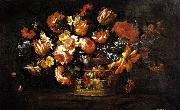La Peinture à l'huile en gros de Chine & Encadre |
|||||||||||

|
|||||||||||
|
|
|
||||||||||||||
|
PASSEROTTI, Bartolomeo
Italian Painter, 1529-1592 |
||||||||||||||
|
|
||||||||||||||
|
||||||||||||||
|
|
||||||||||||||
| PASSEROTTI, Bartolomeo
Italian Painter, 1529-1592 Basket_of_Flowers 54 x 83 cm Museo del Prado, Madrid This painting of a basket of flowers and its pair (Madrid, Museo del Prado) follow closely a type of flower piece made popular by Juan de Arellano in which the flowers occupy an open weave wicker basket placed on a rough stone ledge. Such images of flowers casually arranged and filling an open weave basket differ from the formal presentations of bouquets in vases and were perhaps intended to be seen as recently-gathered fresh flowers on short stems. Although the paintings have been considered early works by P?rez for reasons of their closeness to the typology of Arellano s works, they show that the painter was evidently in full possession of the technical resources that distinguish his mature style. In the 17th century, flower paintings commonly made up the decoration of chapels and monastic institutions. While it does not appear that symbolism played a significant role in Spanish flower paintings, viewers of a more sombre cast of mind could have read a Vanitas message in such pictures, in which the brief life of the flowers was a metaphor for human existence 54 x 83 cm Museo del Prado, Madrid This painting of a basket of flowers and its pair (Madrid, Museo del Prado) follow closely a type of flower piece made popular by Juan de Arellano in which the flowers occupy an open weave wicker basket placed on a rough stone ledge. Such images of flowers casually arranged and filling an open weave basket differ from the formal presentations of bouquets in vases and were perhaps intended to be seen as recently-gathered fresh flowers on short stems. Although the paintings have been considered early works by P?rez for reasons of their closeness to the typology of Arellano s works, they show that the painter was evidently in full possession of the technical resources that distinguish his mature style. In the 17th century, flower paintings commonly made up the decoration of chapels and monastic institutions. While it does not appear that symbolism played a significant role in Spanish flower paintings, viewers of a more sombre cast of mind could have read a Vanitas message in such pictures, in which the brief life of the flowers was a metaphor for human existence |
||||||||||||||
|
Related Paintings to PASSEROTTI, Bartolomeo :. |
||||||||||||||
|
|
||||||||||||||
|
|
||||||||||||||
|
CONTACTER DES Etats-Unis |







